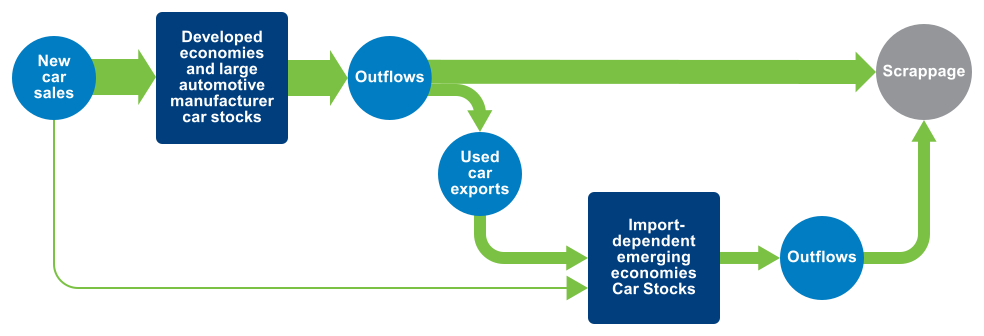Tanya Mohn is a journalist specialising in road safety and more sustainable and active forms of mobility. She is a regular contributor to the New York Times and Forbes, and has reported for the BBC, NBC News, ABC News, PBS, HBO and CNBC.
Image Credit: Holger Schué from Pixabay
Trading in gas-fueled cars for more environmentally-friendly hybrid or electric ones may make consumers feel like they’re doing good to help the planet – lowering CO2 and improving air quality – but where do all the old cars go, and at what cost?
Many unwanted combustion engine cars continue to emit carbon emissions, just in other parts of the world.
“Many conventional vehicles that are sent to emerging markets are often poor quality, old, unsafe, and produce lots of air pollutants,” said Matteo Craglia, co-author with Andreas Kopf of “New but Used: The Electric Vehicle Transition and the Global Second-hand Car Trade,” a new report that examined the global trade in second-hand cars. “As the developed world shifts very quickly to EVs, they are exporting unwanted vehicles at faster rates to the emerging markets.”
The widespread dumping of “dirty” used cars is a global problem, impacting the environment, road safety, and the transition to electric vehicles in the developing world.
Many passenger cars flow from North America, Japan, Korea, and Western Europe to mostly poorer nations in Africa, Asia, and Latin America. In Norway, 9 out of 10 newly registered cars are now electric, but exports of old petrol and diesel cars to other countries have grown by 40% in recent years.
About one-quarter of the world’s people lives in countries where at least half of the cars are imported and second-hand, according to “New but Used,” released in December at COP28, the climate conference in Dubai, by the International Transport Forum, a Paris-based intergovernmental organisation within the Organisation for Economic Cooperation and Development.
I first wrote about this topic several years ago, “Getting Rid of an Old Car? Environmental Problems Often Go With It” for The New York Times, which found that exported substandard used vehicles often didn’t meet the safety and environmental standards in host countries and were no longer roadworthy. Exhaust filters, air bags, and important safety technology like automatic emergency braking systems were poorly monitored, often didn’t work or were removed, undermining the international trade of good quality used cars.
Weak Links: Lack of global standards, insufficient tracking and poor data
Many of those problems remain. Most countries do not impose significant restrictions on trading, so exporting and importing nations need to implement or strengthen regulations to ensure that all second-use vehicles are roadworthy, safe and meet criteria for their emissions performance, “New but Used” found.
Initiatives to establish international standards of cars going to emerging markets are increasing, but are still in the early stages. For example, in Africa, several regional blocs have harmonised regulations so countries within those areas monitor emission standards and limit the import of the worst polluting vehicles, like “ones that produce loads of black smoke out of the tailpipe,” Dr. Craglia said, adding that the UN Environment Programme has played a significant role guiding discussions with importer economies.
On the exporter side, in particular in Europe, talks are moving forward about putting a series of tests and regulations in place to ensure that exported vehicles are sustainable, he added, but a lot more are needed from all exporter economies.
Lack of quality data and ability to monitor individual vehicle specifics, including emissions performance of cars traded across borders, also play a major role in the ability to enforce restrictions and improve the quality of exported cars.
“We suspect there’s a lot of illicit trade,” Drs. Craglia and Kopf noted, “which makes it very hard to trace where vehicles go when they leave developed markets.” Current flows of used vehicles to emerging markets are regularly underreported, and authorities must do more to track them to ensure that regulations are enforced and old vehicles are disposed of safely, including electric vehicles.
The authors also addressed how the dumping of cheap, combustion cars in developing nations could potentially create an over-dependence on cars, undermining sustainable transport strategies that promote public transit and active travel modes, like walking and cycling.
China, for example, where recently there’s been a big shift towards electrification resulting in a surplus of conventional cars, is set to become a major exporter of used vehicles to emerging economies following a recent government regulation that proactively allows used car exports for the first time. “In the coming years, there will be millions of used vehicles from China that are being exported to the rest of the world, mostly to emerging markets,” Dr. Kopf said. The good news, he added, is that the country has guidelines to limit exports to high quality vehicles in good condition, although it is uncertain how long this will last.

The EV Challenge
The transparent reporting of second-hand electric vehicles is crucial to avoid dumping hazardous waste. “Recycling EVs at the end-of-life is significantly more challenging to do according to environmental standards than recycling conventional internal combustion engine vehicles,” Dr. Kopf said, and not dismantling them properly, but having batteries “sit in a scrapyard, has the potential for severe environmental damages, as after a while they will start leaking chemicals.”
There is an upside to the trade of used vehicles: emerging markets have access to affordable cars and the economic opportunities that that entails, and the export of good quality second-hand electric vehicles will help emerging economies decarbonise in the future.
“It’s imperative that unsafe, unroadworthy vehicles do not end up in emerging markets, and that they are properly disposed of,” Dr. Craglia said. “Part of that is making sure that there are regulations and standards in place, but also making sure that there are the data and traceability to enforce that. Governments have a duty to help prevent waste from their country causing environmental harm in other countries.”










